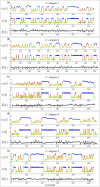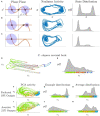Nonlinear Control in the Nematode C. elegans
- PMID: 33551783
- PMCID: PMC7862714
- DOI: 10.3389/fncom.2020.616639
Nonlinear Control in the Nematode C. elegans
Abstract
Recent whole-brain calcium imaging recordings of the nematode C. elegans have demonstrated that the neural activity associated with behavior is dominated by dynamics on a low-dimensional manifold that can be clustered according to behavioral states. Previous models of C. elegans dynamics have either been linear models, which cannot support the existence of multiple fixed points in the system, or Markov-switching models, which do not describe how control signals in C. elegans neural dynamics can produce switches between stable states. It remains unclear how a network of neurons can produce fast and slow timescale dynamics that control transitions between stable states in a single model. We propose a global, nonlinear control model which is minimally parameterized and captures the state transitions described by Markov-switching models with a single dynamical system. The model is fit by reproducing the timeseries of the dominant PCA mode in the calcium imaging data. Long and short time-scale changes in transition statistics can be characterized via changes in a single parameter in the control model. Some of these macro-scale transitions have experimental correlates to single neuro-modulators that seem to act as biological controls, allowing this model to generate testable hypotheses about the effect of these neuro-modulators on the global dynamics. The theory provides an elegant characterization of control in the neuron population dynamics in C. elegans. Moreover, the mathematical structure of the nonlinear control framework provides a paradigm that can be generalized to more complex systems with an arbitrary number of behavioral states.
Keywords: C. elegans; dimensionality reduction; feed-forward control; neural network models; nonlinear control.
Copyright © 2021 Morrison, Fieseler and Kutz.
Conflict of interest statement
The authors declare that the research was conducted in the absence of any commercial or financial relationships that could be construed as a potential conflict of interest.
Figures






References
Grants and funding
LinkOut - more resources
Full Text Sources
Other Literature Sources

